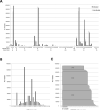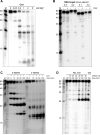Structure and activity of the RNA-targeting Type III-B CRISPR-Cas complex of Thermus thermophilus - PubMed (original) (raw)
. 2013 Oct 10;52(1):135-145.
doi: 10.1016/j.molcel.2013.09.013.
Yoshihiro Agari # 2, Saori Maki-Yonekura # 2, Yifan Zhu 1, David W Taylor 3 4, Esther van Duijn 5, Arjan Barendregt 5, Marnix Vlot 1, Jasper J Koehorst 6, Keiko Sakamoto 2, Akiko Masuda 7, Naoshi Dohmae 7, Peter J Schaap 6, Jennifer A Doudna 4 8, Albert J R Heck 5, Koji Yonekura 2, John van der Oost 1, Akeo Shinkai 2
Affiliations
- PMID: 24119403
- PMCID: PMC4006948
- DOI: 10.1016/j.molcel.2013.09.013
Structure and activity of the RNA-targeting Type III-B CRISPR-Cas complex of Thermus thermophilus
Raymond H J Staals et al. Mol Cell. 2013.
Abstract
The CRISPR-Cas system is a prokaryotic host defense system against genetic elements. The Type III-B CRISPR-Cas system of the bacterium Thermus thermophilus, the TtCmr complex, is composed of six different protein subunits (Cmr1-6) and one crRNA with a stoichiometry of Cmr112131445361:crRNA1. The TtCmr complex copurifies with crRNA species of 40 and 46 nt, originating from a distinct subset of CRISPR loci and spacers. The TtCmr complex cleaves the target RNA at multiple sites with 6 nt intervals via a 5' ruler mechanism. Electron microscopy revealed that the structure of TtCmr resembles a "sea worm" and is composed of a Cmr2-3 heterodimer "tail," a helical backbone of Cmr4 subunits capped by Cmr5 subunits, and a curled "head" containing Cmr1 and Cmr6. Despite having a backbone of only four Cmr4 subunits and being both longer and narrower, the overall architecture of TtCmr resembles that of Type I Cascade complexes.
Copyright © 2013 Elsevier Inc. All rights reserved.
Figures
Figure 1
Schematic representation of CRISPR arrays and cas genes on the genome and plasmid pTT27 of T. thermophilus HB8. CRISPR arrays (1 to 12) are indicated in different grayscales, depending on the repeat type (I, II or III). Cas(-related) genes belonging to a particular CRISPR-Cas subtype are colored in green (subtype III-A), blue (subtype III-B) or yellow (subtype I-E). Additional cas genes are indicated in white. For each of these CRISPR arrays, the bottom panel summarized the genomic location, the representative repeat sequence, repeat type and the number of spacers. The 5’ handles, as found by our deep sequencing analysis, are underlined.
Figure 2
Isolation and characterization of the native TtCmr complex. (A) SDS-PAGE analysis of the T. thermophilus Cmr complex. The purified protein (2 μg) was analyzed on a 15% polyacrylamide gel (lane 2), or an 8% polyacrylamide gel containing 8 M urea (lane 3), and the gels were stained with Coomassie Brilliant Blue R-250. Each subunit is indicated. The Cmr6 has a (His)6-tag at its C-terminus. Lane 1, molecular-weight markers (Bio-Rad Laboratories, Inc.): phosphorylase b (97.4 kDa), serum albumin (66 kDa), ovalbumin (45 kDa), carbonic anhydrase (31 kDa), trypsin inhibitor (21.5 kDa), lysozyme (14.4 kDa). (B) Blue native-PAGE analysis of the T. thermophilus Cmr complex. Two μg of the Cmr complex was analyzed on a 4 to 16% linear polyacrylamide gradient gel in the presence of 0.02% Coomassie Brilliant Blue G-250 (lane 2). Lane 1, molecular weight markers (Sekisui Medical, Co, Ltd.): thyroglobulin (669 kDa), ferritin (443 kDa), lactate dehydrogenase (140 kDa), bovine serum albumin (66.3 kDa), trypsin inhibitor (20.1 kDa). Protein concentration used was determined by the Bradford method (Bradford, 1976), using bovine serum albumin as a standard.
Figure 3
Deep sequencing analysis of the crRNA-content of the TtCmr complex. (A) Distribution of crRNA reads over the 12 CRISPR loci present in the genome of_T. thermophilus_ HB8. (B) Histogram illustrating the size-distribution of the mapped crRNA reads. (C) Deep-sequencing profile of the crRNA reads mapping to CRISPR-4.5. The 5’ handle, which are the first 8 nucleotides, derived from the upstream repeat sequence are indicated in gray. Abundant crRNA species of 34, 40 and 46 nt are indicated in boxes. An overview of all the mapped reads is given in Fig. S4.
Figure 4
Subunit composition of the TtCmr complex. (A) Native nano-electrospray ionization mass spectrum of Cmr. Two major, well-resolved charge state distributions are present at high m/z values, corresponding to complexes of 365 kDa (blue) and 319 kDa (red). More exact masses are provided in Table S1. (B) Cmr (sub)complexes detected by native mass spectrometry. These (sub)complexes were detected and mass analyzed by reconstituting the Cmr complex lacking individual Cmr subunits. More accurate masses and assignments are given in Table S2.
Figure 5
RNA-cleavage activity of the TtCmr complex. (A) An internally labeled RNA substrate complementary to CRISPR-4.5 was incubated with the endogenous Cmr complex for 1 h in the presence of different concentrations of Mg2+. Samples were analyzed by denaturing PAGE, followed by phosphorimaging. (B) Different internally labeled RNA targets (complementary to CRISPR-4.5, 4.2, 2.1 and 3.2) were tested in a similar assay (including 2 mM Mg2+), demonstrating the specificity of the Cmr complex. (C) Activity assay with the endogenous Cmr complex using a 5’ or 3’ labeled RNA substrate (CRISPR-4.5). (D) The 5’ labeled RNA substrate (CRISPR-4.5) was incubated with either the endogenous (“Cmr”) or the reconstituted Cmr complex (“Rec. Cmr”) for the indicated amount of time. The reconstituted complex was pre-loaded with the 43 or the 46 nt crRNA. Reconstituted Cmr complexes without crRNA (“-“) were included as a control. Noncontiguous lanes from the same gel are indicated with dotted lines. The results of a Cmr activity assay with complementary ssDNA and dsDNA substrates are depicted in Fig. S5.
Figure 6
Model for the cleavage activity of the TtCmr complex. Schematic representation of the cleavage activity deduced from the activity assays presented in Fig. 5. Sizes of the different 3’ and 5’ labeled cleavage products, that were observed in these assays, are indicated. Note that over time, the Cmr complex cleaves the RNA substrates from the 3’ end, cutting every 6 nt progressing towards the 5’ end. Cmr4 is the proposed subunit responsible for this catalytic activity, while another Cmr subunit might be responsible for the remaining cleavage.
Figure 7
Molecular architecture of the T. thermophilus Cmr complex. (A) Surface representation of the 3D reconstruction at 26 Å resolution from negatively stained Cmr complexes. The contour level is ~1.5σ. (B) Representative reference-free 2D class averages (upper row), corresponding reprojections (middle row), and surface representation (lower row) of Cmr complexes. The scale bars represent 100 Å. (C) Representative raw particle images of Cmr complexes containing Cmr6-His6 and labeled with NTA-nanogold particles. The scale bars represent 100 Å. (D) Segmentation of the TtCmr complex reconstruction at 22 Å resolution highlighting the ‘sea worm’ architecture. Segmented regions are colored and labeled as: Cmr1/Cmr6 (orange), Cmr2 (purple), Cmr3 (green), Cmr4 (alternating light blue and grey), and Cmr5 (red). (E) The crystal structure of the homologous Cmr2-Cmr3 subcomplex from P. furiosus has been docked into the tail and is color-coded and labeled as in (D).
Comment in
- Same same but different: new structural insight into CRISPR-Cas complexes.
Heidrich N, Vogel J. Heidrich N, et al. Mol Cell. 2013 Oct 10;52(1):4-7. doi: 10.1016/j.molcel.2013.09.023. Mol Cell. 2013. PMID: 24119398
Similar articles
- RNA targeting by the type III-A CRISPR-Cas Csm complex of Thermus thermophilus.
Staals RH, Zhu Y, Taylor DW, Kornfeld JE, Sharma K, Barendregt A, Koehorst JJ, Vlot M, Neupane N, Varossieau K, Sakamoto K, Suzuki T, Dohmae N, Yokoyama S, Schaap PJ, Urlaub H, Heck AJ, Nogales E, Doudna JA, Shinkai A, van der Oost J. Staals RH, et al. Mol Cell. 2014 Nov 20;56(4):518-30. doi: 10.1016/j.molcel.2014.10.005. Epub 2014 Nov 6. Mol Cell. 2014. PMID: 25457165 Free PMC article. - Structure of an RNA silencing complex of the CRISPR-Cas immune system.
Spilman M, Cocozaki A, Hale C, Shao Y, Ramia N, Terns R, Terns M, Li H, Stagg S. Spilman M, et al. Mol Cell. 2013 Oct 10;52(1):146-52. doi: 10.1016/j.molcel.2013.09.008. Mol Cell. 2013. PMID: 24119404 Free PMC article. - Target RNA capture and cleavage by the Cmr type III-B CRISPR-Cas effector complex.
Hale CR, Cocozaki A, Li H, Terns RM, Terns MP. Hale CR, et al. Genes Dev. 2014 Nov 1;28(21):2432-43. doi: 10.1101/gad.250712.114. Genes Dev. 2014. PMID: 25367038 Free PMC article. - CRISPR-based adaptive and heritable immunity in prokaryotes.
van der Oost J, Jore MM, Westra ER, Lundgren M, Brouns SJ. van der Oost J, et al. Trends Biochem Sci. 2009 Aug;34(8):401-7. doi: 10.1016/j.tibs.2009.05.002. Epub 2009 Jul 29. Trends Biochem Sci. 2009. PMID: 19646880 Review. - [Structure and function of Type III-B CRISPR-Cmr complex from Thermus thermophilus].
Shinkai A. Shinkai A. Seikagaku. 2015 Aug;87(4):454-8. Seikagaku. 2015. PMID: 26571617 Review. Japanese. No abstract available.
Cited by
- Structural basis for the type I-F Cas8-HNH system.
Li X, Liu Y, Han J, Zhang L, Liu Z, Wang L, Zhang S, Zhang Q, Fu P, Yin H, Zhu H, Zhang H. Li X, et al. EMBO J. 2024 Oct;43(20):4656-4667. doi: 10.1038/s44318-024-00229-8. Epub 2024 Sep 9. EMBO J. 2024. PMID: 39251884 Free PMC article. - Nanopores Reveal the Stoichiometry of Single Oligoadenylates Produced by Type III CRISPR-Cas.
Fuentenebro Navas D, Steens JA, de Lannoy C, Noordijk B, Pfeffer M, de Ridder D, Staals RHJ, Schmid S. Fuentenebro Navas D, et al. ACS Nano. 2024 Jul 2;18(26):16505-16515. doi: 10.1021/acsnano.3c11769. Epub 2024 Jun 14. ACS Nano. 2024. PMID: 38875527 Free PMC article. - High-efficiency genome editing of an extreme thermophile Thermus thermophilus using endogenous type I and type III CRISPR-Cas systems.
Wang J, Wei J, Li H, Li Y. Wang J, et al. mLife. 2022 Dec 7;1(4):412-427. doi: 10.1002/mlf2.12045. eCollection 2022 Dec. mLife. 2022. PMID: 38818488 Free PMC article. - RNA targeting and cleavage by the type III-Dv CRISPR effector complex.
Schwartz EA, Bravo JPK, Ahsan M, Macias LA, McCafferty CL, Dangerfield TL, Walker JN, Brodbelt JS, Palermo G, Fineran PC, Fagerlund RD, Taylor DW. Schwartz EA, et al. Nat Commun. 2024 Apr 18;15(1):3324. doi: 10.1038/s41467-024-47506-y. Nat Commun. 2024. PMID: 38637512 Free PMC article. - Retention of the RNA ends provides the molecular memory for maintaining the activation of the Csm complex.
Irmisch P, Mogila I, Samatanga B, Tamulaitis G, Seidel R. Irmisch P, et al. Nucleic Acids Res. 2024 Apr 24;52(7):3896-3910. doi: 10.1093/nar/gkae080. Nucleic Acids Res. 2024. PMID: 38340341 Free PMC article.
References
- Agari Y, Sakamoto K, Tamakoshi M, Oshima T, Kuramitsu S, Shinkai A. Transcription profile of Thermus thermophilus CRISPR systems after phage infection. J. Mol. Biol. 2010;395:270–281. - PubMed
- Barrangou R, Fremaux C, Deveau H, Richards M, Boyaval P, Moineau S, Romero DA, Horvath P. CRISPR provides acquired resistance against viruses in prokaryotes. Science. 2007;315:1709–1712. - PubMed
- Bradford MM. A rapid and sensitive method for the quantitation of microgram quantities of protein utilizing the principle of protein-dye binding. Anal. Biochem. 1976;72:248–254. - PubMed
Publication types
MeSH terms
Substances
LinkOut - more resources
Full Text Sources
Other Literature Sources
Research Materials






